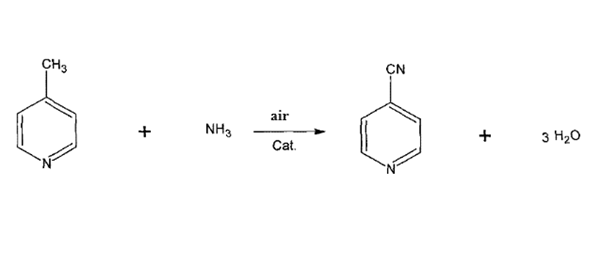| Identification | More | [Name]
4-Cyanopyridine | [CAS]
100-48-1 | [Synonyms]
4-CYANOPYRIDINE
4-PYRIDINECARBONITRILE
AKOS BBS-00004486
ISONICOTINIC ACID NITRILE
ISONICOTINONITRILE
SPECS AC-907/25014099
TIMTEC-BB SBB008923
4-Pyridinenitrile
gamma-Cyanopyridine
Pyridine-4-carbonitrile
Cyanopyridine,4-
4-cyanopyridin
4-Cyanopyridine, Isonicotinic acid nitrile, Isonicotinonitrile | [EINECS(EC#)]
202-856-2 | [Molecular Formula]
C6H4N2 | [MDL Number]
MFCD00006417 | [Molecular Weight]
104.11 | [MOL File]
100-48-1.mol |
| Chemical Properties | Back Directory | [Appearance]
The cyanopyridines are as follows: 2-cyano-:
A white to tan liquid or solid. Almond odor. Boiling
point=2213℃
; freezing/melting point=27℃
; flash
point=89℃
. 3-cyano-: a colorless liquid or gray crystal-
line solid. | [Melting point ]
76-79 °C(lit.)
| [Boiling point ]
196 °C
| [density ]
1.1145 (rough estimate) | [vapor pressure ]
41.9Pa at 25℃ | [refractive index ]
1.5242 (estimate) | [Fp ]
88 °C
| [storage temp. ]
Sealed in dry,Room Temperature | [solubility ]
40g/l | [form ]
Crystals or Powder | [pka]
pK1:1.90(+1) (25°C) | [color ]
White to off-white | [Stability:]
Stable. Incompatible with strong bases, strong oxidizing agents, strong acids. | [Water Solubility ]
3.2 g/100ml (16.4 ºC) | [BRN ]
107712 | [Exposure limits]
NIOSH: IDLH 25 mg/m3 | [InChIKey]
GPHQHTOMRSGBNZ-UHFFFAOYSA-N | [LogP]
0.46 at 25℃ | [CAS DataBase Reference]
100-48-1(CAS DataBase Reference) | [NIST Chemistry Reference]
4-Pyridinecarbonitrile(100-48-1) | [EPA Substance Registry System]
4-Pyridinecarbonitrile (100-48-1) |
| Safety Data | Back Directory | [Hazard Codes ]
Xn | [Risk Statements ]
R20/21/22:Harmful by inhalation, in contact with skin and if swallowed . | [Safety Statements ]
S36/37:Wear suitable protective clothing and gloves .
S24/25:Avoid contact with skin and eyes . | [RIDADR ]
3276 | [WGK Germany ]
3
| [TSCA ]
Yes | [PackingGroup ]
III | [HS Code ]
29333999 |
| Hazard Information | Back Directory | [Potential Exposure]
Limits in Air
NIOSH IDLH525 mg/m3
NIOSH REL: (nitriles) 2 ppm, Ceiling Concentration, not
to be exceeded in any 15-minute work period. | [First aid]
If this chemical gets into the eyes, remove any
contact lenses at once and irrigate immediately for at least
15 minutes, occasionally lifting upper and lower lids. Seek
Medical attention immediately. If this chemical contacts the
skin, remove contaminated clothing and wash immediately
with soap and water. Seek medical attention immediately. If
this chemical has been inhaled, remove from exposure, begin
rescue breathing (using universal precautions, including
resuscitation mask) if breathing has stopped and CPR if
heart action has stopped. Transfer promptly to a medical
facility. When this chemical has been swallowed, get medi-
cal attention. Give large quantities of water and induce
vomiting. Do not make an unconscious person vomit. | [Shipping]
UN3276 Nitriles, liquid, toxic, n.o.s., Hazard
Class: 6.1; Labels: 6.1-Poisonous materials, Technical
Name Required, Potential Inhalation Hazard (Special
Provision 5). | [Incompatibilities]
Oxidizing agents, such as perchlorates,
peroxides, and permanganates. Nitriles may polymerize in
the presence of metals and some metal compounds. They
are incompatible with acids; mixing nitriles with strong
oxidizing acids can lead to extremely violent reactions.
Nitriles are generally incompatible with other oxidizing
agents such as peroxides and epoxides. The combination of
bases and nitriles can produce hydrogen cyanide. Nitriles
are hydrolyzed in both aqueous acid and base to give car-
boxylic acids (or salts of carboxylic acids). These reactions
generate heat. Peroxides convert nitriles to amides. Nitriles
can react vigorously with reducing agents. Acetonitrile and
propionitrile are soluble in water, but nitriles higher than
propionitrile have low aqueous solubility. They are also
insoluble in aqueous acids
. | [Chemical Properties]
beige solid | [Chemical Properties]
The cyanopyridines are as follows: 2-cyano-:
A white to tan liquid or solid. Almond odor. Boiling
point=2213℃
; freezing/melting point=27℃
; flash
point=89℃
. 3-cyano-: a colorless liquid or gray crystal-
line solid. | [Uses]
4-Cyanopyridine(100-48-1) is used as an intermediate in organic synthesis and pharmaceutical substances like isonicotinylhydrazide, which is used in the treatment of tuberculosis. It is used as a precursor for the preparation of isonicotinic acid and 4-diemthylaminopyridine (DMAP). It is involved in the synthesis of 6-methyl-2-pyridin-4-yl-pyrimidin-4-ylamine by reacting with acetonitrile.
| [Synthesis]
4-Cyanopyridine (100-48-1) is synthesised by the reaction of 4-methylpyridine with ammonia and air in the presence of a catalyst. The specific synthesis steps are as follows:
4-Methylpyridine and ammonia vaporisation preheating to 180-330°C, then into the mixing tank and air mixing uniformly, into the fixed-bed reactor by the top of the fixed-bed reactor after the distribution of the catalyst-filled reactor, the control of the reaction temperature in the range of 330-450 ° C, the reaction head pressure is controlled in the range of 0.020-0.070 KPa, the reaction temperature is controlled by molten salts, the reaction gas after the end of the reaction After the reaction, the reaction gas was condensed to sub-zero fractionation to obtain the crude product of 4-cyanopyridine, and the crude product was distilled to obtain the finished product of 4-cyanopyridine. The conversion rate of 4-methylpyridine was above 99%, and the yield of 4-cyanopyridine was above 98%.

|
|
|